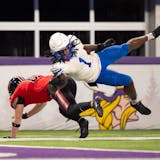Our nation has once again been pitched headlong into the maelstrom of race, crime and law enforcement. In the wake of shootings by police of black men in Louisiana and in Falcon Heights, Minn., we've again heard shrill accusations that cops are racists out to get black men and have watched as Black Lives Matter protesters shut down freeways. We've grieved for cops gunned down in Dallas and Baton Rouge.
Again, we've heard public officials, including Gov. Mark Dayton, denounce police as bigots before the facts of an incident are known.
Folks, it's "get real" time. What price are we paying for ignoring reality — including the demographics of crime; the deadly, split-second environment in which the police work, and the potential for reckless public policies to undermine our communities' safety?
Minneapolis offers an instructive case study. Here, starting in November 2015, Black Lives Matter and other activists wreaked havoc for weeks protesting the death of Jamar Clark. Clark was a 24-year-old with at least 20 previous arrests. He assaulted a woman; blocked paramedics from treating her; refused to comply with officers' order to take his hands from his pockets, and was shot as he tried to grab an officer's gun.
Hennepin County Attorney Mike Freeman found the actions of the two officers involved to be justified after an exhaustive evidentiary review. But Black Lives Matter and the Minneapolis NAACP — like their counterparts in Ferguson, Mo., Baltimore and elsewhere — showed no interest in the facts. They continued their crusade against the officers, whose lives are now in shambles.
After the Clark affair, Minneapolis police officers understood how great a risk they face of having their reputations destroyed — or even being slapped with a criminal indictment — if things go bad in a single incident. So they began to back off the sort of proactive policing — like traffic and suspicious-person stops — that prevents higher-level crimes and gets guns off the street.
By mid-July, shootings in Minneapolis were up 46 percent compared with the same time last year, though in the last couple weeks of July the increase dipped to 24 percent — perhaps a temporary blip. On the North Side, law-abiding citizens say that violent crime, up 11 percent, is suffocating their neighborhoods, and they plead for more law enforcement.
This appears to be the so-called Ferguson effect, which is on full display in cities such as Baltimore and Chicago, where shootings have soared.



